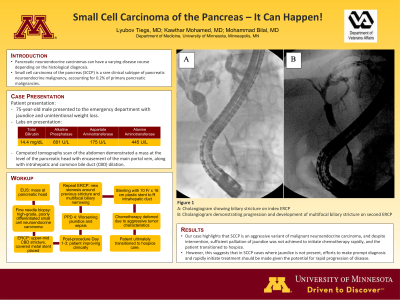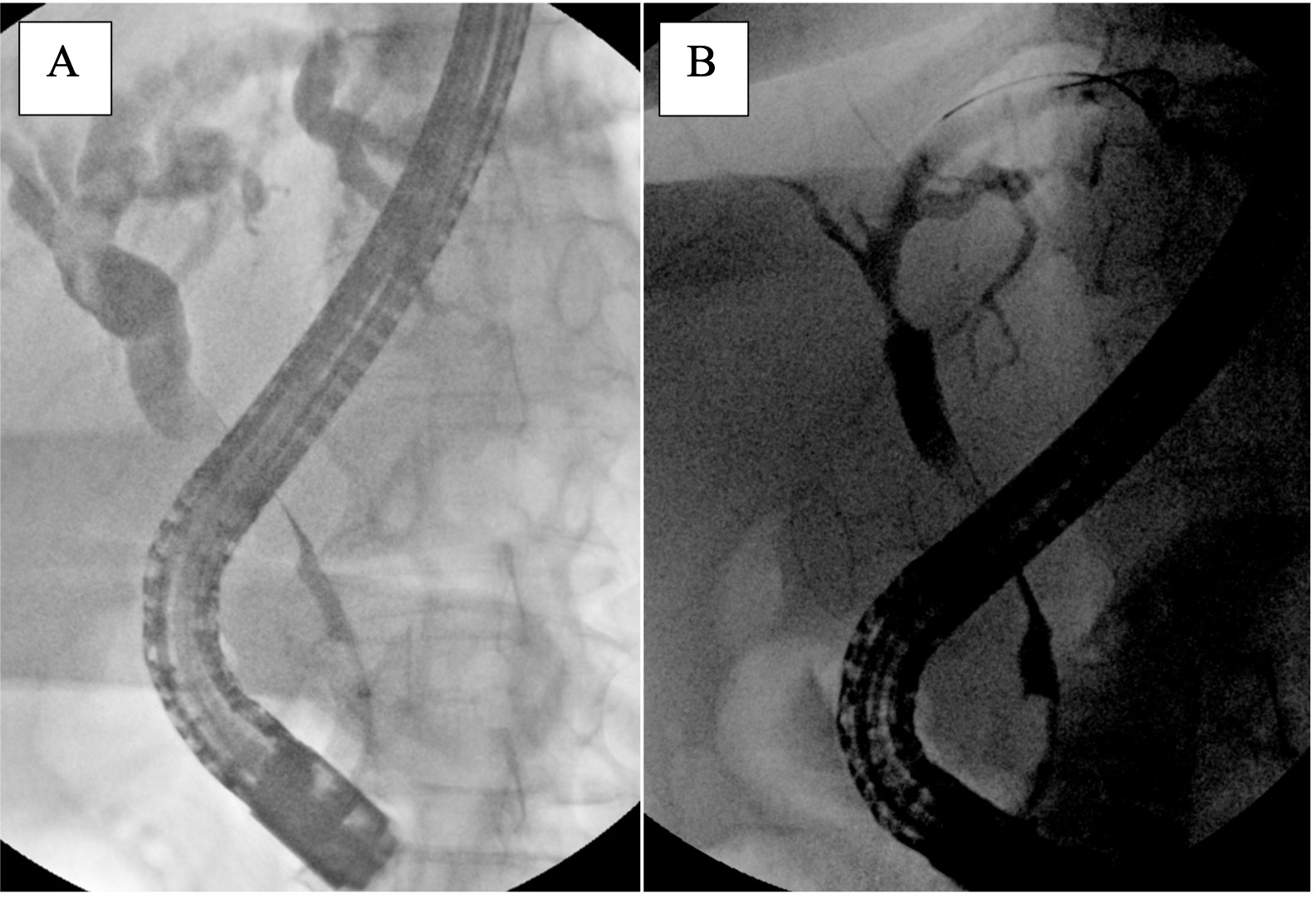Tuesday Poster Session
Category: Biliary/Pancreas
P3563 - Small Cell Carcinoma of the Pancreas – It Can Happen!
Tuesday, October 29, 2024
10:30 AM - 4:00 PM ET
Location: Exhibit Hall E

Has Audio
- LT
Lyubov Tiegs, MD
University of Minnesota
Minneapolis, MN
Presenting Author(s)
Lyubov Tiegs, MD1, Kawthar Mohamed, MD1, Mohammad Bilal, MD2
1University of Minnesota, Minneapolis, MN; 2University of Minnesota and Minneapolis VA Health Care System, Minneapolis, MN
Introduction: Pancreatic neuroendocrine carcinomas can have a varying disease course depending on the histological diagnosis. Small cell carcinoma of the pancreas (SCCP) is a rare clinical subtype of pancreatic neuroendocrine malignancy, accounting for 0.2% of primary pancreatic malignancies. Herein, we present a case of rapid progression of SCCP.
Case Description/Methods: A 75-year-old male presented to the emergency department with jaundice and unintentional weight loss. Initial laboratory data showed total bilirubin of 14.4 mg/dL, alkaline phosphatase 601 U/L, aspartate aminotransferase 175 U/L, and alanine aminotransferase 445 U/L. Computed tomography scan of the abdomen demonstrated a mass at the level of the pancreatic head with encasement of the main portal vein, along with intrahepatic and common bile duct (CBD) dilation. The decision was made to perform endoscopic ultrasound (EUS) for diagnosis of the pancreatic mass and endoscopic retrograde cholangiopancreatography (ERCP) for biliary decompression. EUS identified a mass at the pancreatic head, and fine needle biopsy confirmed high-grade poorly differentiated small cell neuroendocrine carcinoma. ERCP demonstrated a stricture in the upper to mid CBD (Figure 1A), and a fully covered metal stent was placed across the stricture. Patient did well post-operatively, but on day 4 after the endoscopic procedure, he developed worsening jaundice and sepsis. The decision was made to perform repeat ERCP for stent interrogation. The cholangiogram revealed new stenosis above the previously seen CBD stricture (Figure 1B), as well as multifocal narrowing in the right biliary tree. Successful stenting was achieved with a 10 French by 16 cm straight plastic stent into the right intrahepatic duct. Unfortunately, elevated serum total bilirubin levels, poor performance status, and the aggressive nature of this SCCP, it was determined that patient would not be a candidate for urgent chemotherapy. After discussion with the family, the patient was ultimately transitioned to hospice care.
Discussion: Our case highlights that SCCP is an aggressive variant of malignant neuroendocrine carcinoma, and despite early intervention, sufficient palliation of jaundice was not achieved to initiate chemotherapy rapidly, and the patient transitioned to hospice. However, this suggests that in SCCP cases where jaundice is not present, efforts to make prompt diagnosis and rapidly initiate treatment should be made given the potential for rapid progression of disease.

Disclosures:
Lyubov Tiegs, MD1, Kawthar Mohamed, MD1, Mohammad Bilal, MD2. P3563 - Small Cell Carcinoma of the Pancreas – It Can Happen!, ACG 2024 Annual Scientific Meeting Abstracts. Philadelphia, PA: American College of Gastroenterology.
1University of Minnesota, Minneapolis, MN; 2University of Minnesota and Minneapolis VA Health Care System, Minneapolis, MN
Introduction: Pancreatic neuroendocrine carcinomas can have a varying disease course depending on the histological diagnosis. Small cell carcinoma of the pancreas (SCCP) is a rare clinical subtype of pancreatic neuroendocrine malignancy, accounting for 0.2% of primary pancreatic malignancies. Herein, we present a case of rapid progression of SCCP.
Case Description/Methods: A 75-year-old male presented to the emergency department with jaundice and unintentional weight loss. Initial laboratory data showed total bilirubin of 14.4 mg/dL, alkaline phosphatase 601 U/L, aspartate aminotransferase 175 U/L, and alanine aminotransferase 445 U/L. Computed tomography scan of the abdomen demonstrated a mass at the level of the pancreatic head with encasement of the main portal vein, along with intrahepatic and common bile duct (CBD) dilation. The decision was made to perform endoscopic ultrasound (EUS) for diagnosis of the pancreatic mass and endoscopic retrograde cholangiopancreatography (ERCP) for biliary decompression. EUS identified a mass at the pancreatic head, and fine needle biopsy confirmed high-grade poorly differentiated small cell neuroendocrine carcinoma. ERCP demonstrated a stricture in the upper to mid CBD (Figure 1A), and a fully covered metal stent was placed across the stricture. Patient did well post-operatively, but on day 4 after the endoscopic procedure, he developed worsening jaundice and sepsis. The decision was made to perform repeat ERCP for stent interrogation. The cholangiogram revealed new stenosis above the previously seen CBD stricture (Figure 1B), as well as multifocal narrowing in the right biliary tree. Successful stenting was achieved with a 10 French by 16 cm straight plastic stent into the right intrahepatic duct. Unfortunately, elevated serum total bilirubin levels, poor performance status, and the aggressive nature of this SCCP, it was determined that patient would not be a candidate for urgent chemotherapy. After discussion with the family, the patient was ultimately transitioned to hospice care.
Discussion: Our case highlights that SCCP is an aggressive variant of malignant neuroendocrine carcinoma, and despite early intervention, sufficient palliation of jaundice was not achieved to initiate chemotherapy rapidly, and the patient transitioned to hospice. However, this suggests that in SCCP cases where jaundice is not present, efforts to make prompt diagnosis and rapidly initiate treatment should be made given the potential for rapid progression of disease.

Figure: Figure 1
A: Cholangiogram showing biliary stricture on index ERCP
B: Cholangiogram demonstrating progression and development of multifocal biliary stricture on second ERCP
A: Cholangiogram showing biliary stricture on index ERCP
B: Cholangiogram demonstrating progression and development of multifocal biliary stricture on second ERCP
Disclosures:
Lyubov Tiegs indicated no relevant financial relationships.
Kawthar Mohamed indicated no relevant financial relationships.
Mohammad Bilal: Boston Scientific – Consultant. Cook endoscopy – Speakers Bureau.
Lyubov Tiegs, MD1, Kawthar Mohamed, MD1, Mohammad Bilal, MD2. P3563 - Small Cell Carcinoma of the Pancreas – It Can Happen!, ACG 2024 Annual Scientific Meeting Abstracts. Philadelphia, PA: American College of Gastroenterology.
